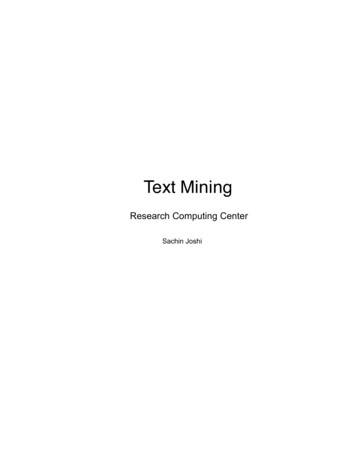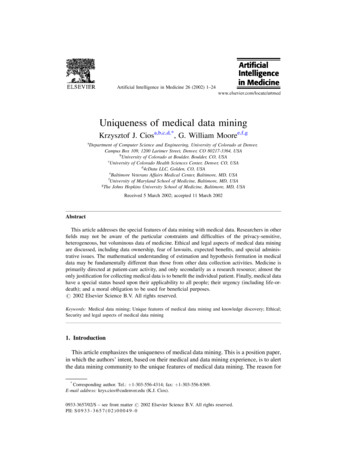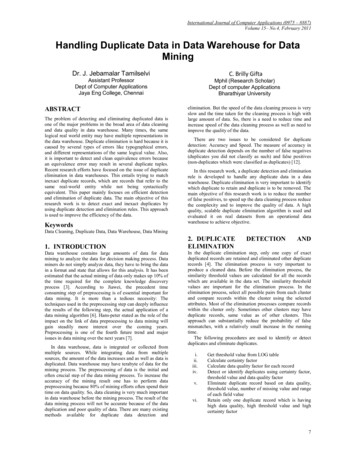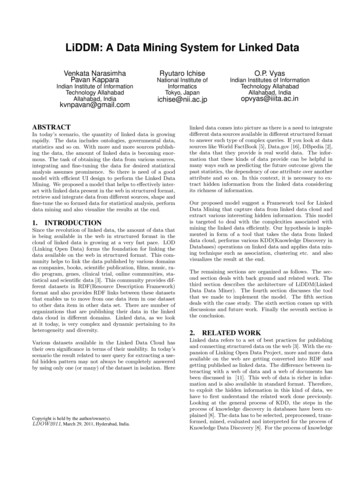
Transcription
SyllabusCourseInformationInstructorMIS 431: Data Mining for Business ApplicationsLocation: Distance EducationCourse Website: https://gmudatamining.comDavid SvancerOffice Hours – Available through SlackCourseDescriptionData mining—the art of extracting useful information from large amounts ofdata—is of growing importance in today’s world. The amount of data flowing from,to, and through enterprises is enormous, and growing rapidly—more rapidly thanthe capabilities of organizations to use it. Enterprises are trying to make effectiveuse of the abundance of data to which they have access: to make betterpredictions, decisions, and strategies. Therefore, managers now need to knowabout the possibilities and limitations of data mining. This course introduces datamining problems and tools to enhance managerial decision making. Students willlearn how to ask the right questions and how to draw inferences from data byusing the appropriate data mining tools. This course will enable students toapproach business problems data-analytically, envision data mining opportunitiesin organizations, and follow up on ideas or opportunities that present themselves.CourseObjectivesUpon completion of the course, students will be able to:1. Describe the cross-industry standard process for data mining (CRISP-DM)and its application across various industries in business.2. Execute a data mining project, from setting analytical goals tocommunication of results.3. Apply modern software tools to prepare data, visualize complex datasets,and build machine learning models.4. Assess the accuracy of different machine learning techniques in the contextof specific business objectives and datasets.5. Utilize advanced programming techniques and applied statistics tocomplete a data mining project and present business recommendationsthat highlight opportunities for extracting business value.6. Recommend solutions to a high-level business problem using data miningalgorithms.
CourseMethodologyThe class format will combine reading, lectures, presentations, and other learningtools. The class will be interactive and require every student to be engaged in theclassroom discussion and assignments. In addition to the lectures, screencasts andtimely completion of assignments, every student will be expected to be an activeparticipant and a dedicated individual applying what you learn to every element ofthe course work.Required TextRequiredTextbooksR for Data Science (https://r4ds.had.co.nz/)An Introduction to Statistical Learning (http://www-bcf.usc.edu/ gareth/ISL/)Statistical Inference via Data Science (https://moderndive.com/)Hardware: You will need access to a Windows or Macintosh computer with at least2 GB of RAM and access to a fast and reliable broadband internet connection (e.g.,cable, DSL). A larger screen is recommended for better visibility of course material.You will need speakers or headphones to hear recorded content and a headsetwith a microphone is recommended for the best experience. For the amount ofHard Disk Space required taking a distance education course, consider and allowfor:1. the storage amount needed to install any additional software and2. space to store work that you will do for the course.If you consider the purchase of a new computer, please go to Patriot Tech to seerecommendations.ComputerRequirementsSoftware: Many courses use Blackboard as the learning management system.You will need a browser and operating system that are listed compatible orcertified with the Blackboard version available on the myMason Portal. Seesupported browsers and operating systems. Log in to myMason to access yourregistered courses. Some courses may use other learning management systems.Check the syllabus or contact the instructor for details. Online courses typicallyuse Acrobat Reader, Flash, Java, and Windows Media Player, QuickTime and/orReal Media Player. Your computer should be capable of running current versionsof those applications. Also, make sure your computer is protected from viruses bydownloading the latest version of Symantec Endpoint Protection/Anti-Virussoftware for free here.Students owning Macs or Linux should be aware that some courses may usesoftware that only runs on Windows. You can set up a Mac computer with BootCamp or virtualization software so Windows will also run on it. Watch this video
about using Windows on a Mac. Computers running Linux can also be configuredwith virtualization software or configured to dual boot with Windows.Note: If you are using an employer-provided computer or corporate office forclass attendance, please verify with your systems administrators that you will beable to install the necessary applications and that system or corporate firewalls donot block access to any sites or media types.Course-specific Software:RStudio CloudOpen source data science and statistical computing software available through acloud-based application.An R environment will be set-up for students in MIS 431 and an access link will beprovided through Blackboard.When creating an account on https://rstudio.cloud, students must use their GMUe-mail address.Available at the following link: https://rstudio.cloud/RStudio Cloud Guide: https://rstudio.cloud/learn/guideDataCampDataCamp (https://datacamp.com) offers interactive R and Python courses ontopics in data science, statistics, and machine learning. Students can learn throughshort video tutorials and interactive exercises from within their web browser.Courses on DataCamp do not require any software installation to complete.Students in MIS 431 have been granted access to all DataCamp courses for a 6month period. DataCamp will serve as a tool for MIS 431 students to enablelearning programming concepts through hands-on interactive exercises.In MIS 431, students are required to complete three DataCamp courses during thesemester (150 points towards the final grade). Each course requires approximately4 to 6 hours to complete.
Links to the description of the courses are provided below.Introduction to n-to-rIntroduction to the tion-to-the-tidyverseWorking with Data in the with-data-in-the-tidyverseStudents will receive an access link to join the MIS 431 team in DataCamp throughBlackboard. After clicking the link, students will first be prompted to create anaccount. Students must use their GMU e-mail address to enroll(username@gmu.edu) and add their name as it appears in GMU records.SlackSlack (https://slack.com/) is a tool for collaboration where students can interactwith their peers as well as the professor throughout the course.Students will receive an access link to join the MIS 431 Slack group.Course WebsiteBlackboard 9.1 will be used for this course. You can access the site athttp://mymasonportal.gmu.edu. Login and click on the “Courses” tab. You will seeMIS 431 course. NOTE: Username and passwords are the same as your Masonemail account. You must have consistent access to an internet connection in orderto complete the assignments in this course through Blackboard(http://mymason.gmu.edu). Note the technology requirements for School ofBusiness in your Blackboard course menu—it contains details of minimumtechnology requirements.The course website is at the following link: https://gmudatamining.comParticipationLearning can only happen when you are playing an active role. It is important toplace more emphasis on developing your insights and skills, rather thantransmitting information. Knowledge is more important than facts and definitions.
It is a way of looking at the world, an ability to interpret and organize futureinformation. An active learning approach will more likely result in long-termretention and better understanding because you make the content of what youare learning concrete and real in your mind.Although an active role can look differently for various individuals, it is expected inthis class that you will work to explore issues and ideas under the guidance of theprofessor and your peers. You can do this by reflecting on the content andactivities of this course, asking questions, striving for answers, interpretingobservations, and discussing issues with your peers.Rules andExpectationsMason HonorCodeIn correspondence/communication students will be expected to:a) Be professional and respectful in correspondenceb) Make reasonable requests of the instructor. We will be happy to clarifycourse material and answer legitimate questions; however, please exhaustother information sources (e.g., syllabus, Blackboard) for answering yourquestion before contacting me and remember, “Poor planning on yourpart does not constitute an emergency on my part”Regarding honesty in work students will be expected to:a) Review the University integrity and honesty policies in the studenthandbook for guidelines regarding plagiarism and cheating (summarizedbelow). I will gladly clarify my stance on any questionable or “grey area”issues you may have.b) Refrain from dishonest work as it will receive a minimum penalty of zeroon the assignment and a maximum penalty of a zero for the course with areport to the Honor committee. The GMU Honor Code requires thatfaculty submit any suspected Honor Code violations to the HonorCommittee. Therefore, any suspected offense will be submitted foradjudication.The complete Honor Code is as follows:To promote a stronger sense of mutual responsibility, respect, trust, and fairnessamong all members of the George Mason University community and with the desire forgreater academic and personal achievement, we, the student members of theuniversity community, have set forth this honor code: Student members of theGeorge Mason University community pledge not to cheat, plagiarize, steal,or lie in matters related to academic work.(From the Catalog – catalog.gmu.edu)Cheating PolicyAny form of cheating on an activity, project, or exam will result in zero pointsearned.“Cheating” includes, but is not limited to, the following: reviewing others’ exam
papers, having ANY resources utilized when not allowed, collaborating withanother student during an individual assignment.If you have questions about when the contributions of others to your work mustbe acknowledged and appropriate ways to cite those contributions, please talkwith the professor or utilize the GMU writing center.Plagiarism andthe InternetCopyright rules also apply to users of the Internet who cite from Internetsources. Information and graphics accessed electronically must also be cited,giving credit to the sources.This material includes but is not limited to e-mail (don't cite or forward someoneelse's e-mail without permission), newsgroup material, information from Websites, including graphics. Even if you give credit, you must get permission fromthe original source to put any graphic that you did not create on your web page.Shareware graphics are not free. Freeware clipart is available for you to freelyuse. If the material does not say "free," assume it is not.Putting someone else's Internet material on your web page is stealing intellectualproperty. Making links to a site is, at this time, okay, but getting permission isstrongly advised, since many Web sites have their own requirements for linkingto their material. Review the Honor Code here.Individuals withDisabilitiesStudents with documented disabilities should contact the Office of DisabilityServices (703) 993-2474) to learn more about accommodations that may beavailable to them.(From the 2019-2020 Catalog – catalog.gmu.edu)AcademicIntegrity andInclusivityStudent PrivacyPolicyThis course embodies the perspective that we all have differing perspectives andideas and we each deserve the opportunity to share our thoughts. Therefore, wewill conduct our discussions with respect for those differences. That means, weeach have the freedom to express our ideas, but we should also do so keeping inmind that our colleagues deserve to hear differing thoughts in a respectfulmanner, i.e. we may disagree without being disagreeable. http://oai.gmu.edu/George Mason University strives to fully comply with FERPA by protecting theprivacy of student records and judiciously evaluating requests for release ofinformation from those records.Please see George Mason University’s student privacy -Mail PolicyWeb: masonlive.gmu.eduMason uses electronic mail to provide official information to students. Examplesinclude notices from the library, notices about academic standing, financial aidinformation, class materials, assignments, questions, and instructor feedback.
Students are responsible for the content of university communication sent to theirMason e-mail account and are required to activate that account and check itregularly.Students are also expected to maintain an active and accurate mailing address toreceive communications sent through the United States Postal Service.(From the 2017-18 Catalog – catalog.gmu.edu)Course Grading& EvaluationGrades will be assigned as follows:A : 93.00 - 100%A- : 89.50 - 92.99%B : 86.50 - 89.49%B : 81.50 - 86.49%B- : 79.50 - 81.49%C : 77.50 - 79.49%C : 69.50 - 77.49%C- : 64.50 - 69.49%D : 59.50 - 64.49%F : 0 - 59.49%Writing IntensiveRequirementThis course has been approved by the Faculty Senate Writing Across theCurriculum Committee to fulfill all/in part the Writing Intensive requirement in theBusiness Analytics Concentration. It does so through the course projects wherestudents will be writing executive summaries of their data analysis and modelingresults within a particular business context. The data analysis project will becompleted through a draft/feedback/revision process. The first draft will be due11-08-2020; I will provide commentary on the draft, and the revised draft will bedue on 11-15-2020.ClassParticipation(10 Points)Students are required to create at least on post to the # introductions Slack channelwhere they briefly describe their major, career goals, and skills they lookforwarding to learning in MIS 431.Quiz(15 Points)One Quiz will be administered through Blackboard and will test the studentsunderstanding of machine learning algorithms.DataCampCourses(150 Points)Students are required to complete the 3 DataCamp courses listed in the Softwarerequirements section of the syllabus. Successful completion of each course isworth 50 points. To get credit, students must upload their DataCamp Statement ofAccomplishment in PDF format to the MIS 431 Blackboard site.HomeworkAssignments(75 Points)Students will complete 3 programming homework assignments.
Midterm DataAnalysis Project(100 Points)Final Project(150 Points)Students will complete a data analysis project utilizing RStudio Cloud and theprogramming techniques that were covered in the first 7 sessions of the courseStudents will complete a final project utilizing RStudio Cloud and the programmingtechniques that were covered in the first 13 sessions of the course. The finalproject will be a complete implementation of the data mining process to abusiness problem and will build upon the skills developed in the midterm dataanalysis project.Need Help?Utilize the “Course Q&A” discussion forum or email your instructor directly.Expect to work 10-15 hours per week on learning material and course assignments for thiscourse.Unless otherwise stated, all assignments are due by the end of the week in which they areassigned. For the purposes of this course, a week is defined as beginning at 12:01 ameach Monday EST, and ending at 11:59 pm on the following Sunday EST.To help you manage your schedule and time to complete the assignments in this course,please follow the recommended timeline below. If you have a question or concern orencounter a problem about an assignment, please contact me immediately so we candiscuss and work out a resolution.WeekWeek 108-24Week 208-31Week 309-07Week 4LessonsAssignments Due (by Sunday 11:59 pm)Lesson 1: Introduction to Data Mining Introduction to R Programming Register and access course softwareo DataCampo RStudio Cloudo Slack Course Participationo # introductions post to SlackLesson 2: Data Mining Process (CRISP-DM) Intermediate R programming DataCampo Introduction to RLesson 3: Introduction to data analysis with dplyr Quiz - BlackboardLesson 4: DataCamp
09-14 Intermediate data analysis with dplyrWeek 509-21Lesson 5: Joining related data frames Reshaping and pivoting data with tidyrWeek 609-28Lesson 6: Data Visualization with ggplot2Week 710-05Lesson 7: Probability and Descriptive StatisticsWeek 810-12Lesson 8: Inferential Statistics and ResamplingWeek 910-19Lesson 9: Model Training Processo Data Preprocessing and FeatureEngineering for Machine Learningo Cross ValidationWeek 1010-26Lesson 10: Linear Regressiono One predictoro Multiple predictorsoIntroduction to the Tidyverse DataCampo Working with Data in the Tidyverse Homework #1 Data Analysis ProjectWeek 1111-02Lesson 11: Introduction to Classificationo Logistic Regressiono Assessing Model Fit F-1 score, Precision, Recall,ROC, AUC Week 1211-09Lesson 12: Discriminant Analysiso LDA, QDA K-Nearest Neighbors (KNN) Intro to Hyperparameter TuningHomework #2 – Executive Summaryrevision for the Data Analysis ProjectWeek 1311-16Lesson 13: Decision Trees and Random Forests Hyperparameter tuning with grid search Homework # 3Week 1411-23Thanksgiving HolidayEnjoy time with your loved ones
Week 1511-30Lesson 14: Introduction to Unsupervised Learningo Principal Components Analysiso K-means Clustering Final Project
MIS 431: Data Mining for Business Applications Location: Distance Education Course Website: https://gmudatamining.com Instructor David Svancer Office Hours - Available through Slack Course Description Data mining—the art of extracting useful information from large amounts of data—is of growing importance in today's world.











